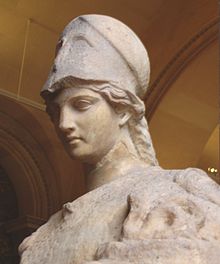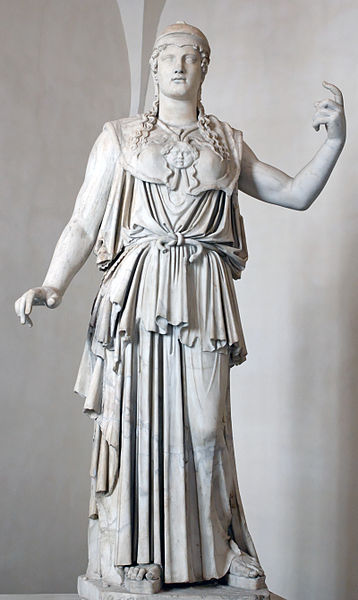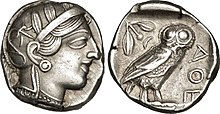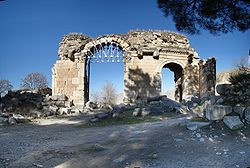|
Greek city of Seleukeia in Cilicia
Bronze 22mm (6.75 grams) Struck 2nd-1st Century B.C.
Reference: Sear 5591; B.M.C. 21. 128, 2
Head of Athena right, in crested Corinthian helmet.
ΣΕΛΕΥΚΕΩΝ ΤΩΝ ΠΡΟΣ ΤΩΙ ΚΑΛΥΚΑΔΝΩΙ, Nike advancing
left, holding wreath;
in field to left, mongram; in field to right, E.
Founded by Seleukos I on the
lower course of the river Kalykadnos, Seleukeia absorbed
the population of Holmi,
a few miles to the south. It grew into a city of great
wealth and importance
rivaling Tarsos.
You are bidding on the exact
item pictured, provided with a Certificate of Authenticity and Lifetime
Guarantee of Authenticity.
In
Greek mythology
,
Nike
was a goddess
who personified
victory
, also known as the Winged Goddess of
Victory. The Roman equivalent was
Victoria
. Depending upon the time of various
myths, she was described as the daughter of
Pallas
(Titan) and
Styx (Water) and the sister of
Kratos
(Strength),
Bia
(Force), and
Zelus
(Zeal). Nike and her siblings were close
companions of Zeus
, the dominant deity of the
Greek pantheon
. According to classical (later)
myth, Styx brought them to Zeus when

the
god was assembling allies for the
Titan War
against the older deities. Nike
assumed the role of the divine
charioteer
, a role in which she often is
portrayed in Classical Greek art. Nike flew around battlefields rewarding the
victors with glory and fame.
Nike is seen with wings in most statues and paintings. Most other winged
deities in the Greek pantheon had shed their wings by Classical times. Nike is
the goddess of strength, speed, and victory. Nike was a very close acquaintance
of Athena
, and is thought to have stood in
Athena’s outstretched hand in the statue of Athena located in the Parthenon.
Nike is one of the most commonly portrayed figures on Greek coins.
Names stemming from Nike include amongst others:
Nicholas
, Nicola, Nick, Nikolai, Nils, Klaas,
Nicole, Ike, Niki, Nikita, Nika, Niketas, and Nico.

Helmeted Athena with the cista and Erichthonius in his serpent form.
Roman, first century (Louvre
Museum)
In
Greek religion
and
mythology
, Athena or Athene, also
referred to as Pallas Athena/Athene , is the goddess of wisdom, courage,
inspiration, civilization, law and justice, just warfare, mathematics, strength,
strategy, the arts, crafts, and skill.
Minerva
is the
Roman goddess
identified with
Athena.

Athena is also a shrewd companion of
heroes and is the
goddess
of heroic endeavour. She is the
virgin
patroness of
Athens
. The Athenians founded the
Parthenon
on the Acropolis of her namesake
city, Athens (Athena Parthenos), in her honour.
Athena’s veneration as the patron of Athens seems to have existed from the
earliest times, and was so persistent that archaic myths about her were recast
to adapt to cultural changes. In her role as a protector of the city (polis),
many people throughout the Greek world worshiped Athena as Athena Polias
(Ἀθηνᾶ Πολιάς “Athena of the city”). The city of
Athens
and the goddess Athena essentially bear
the same name, “Athenai” meaning “[many] Athenas”.
Patroness

Athenian
tetradrachm
representing the
goddess Athena
Athena as the goddess of philosophy became an aspect of the cult in Classical
Greece during the late 5th century B.C. She is the patroness of various crafts,
especially of weaving
, as Athena Ergane, and was
honored as such at festivals such as
Chalceia
. The metalwork of weapons also fell
under her patronage. She led battles (Athena
Promachos or the warrior maiden Athena Parthenos) as the
disciplined, strategic side of war, in contrast to her brother
Ares, the patron of violence, bloodlust and slaughter—”the raw force
of war”. Athena’s wisdom includes the cunning intelligence (metis) of
such figures as Odysseus
. Not only was this version of Athena
the opposite of Ares in combat, it was also the polar opposite of the serene
earth goddess version of the deity, Athena Polias.
Athena appears in Greek mythology as the patron and helper of many heroes,
including Odysseus
,
Jason
, and
Heracles
. In
Classical Greek
myths, she never consorts with
a lover, nor does she ever marry,earning the title Athena Parthenos. A
remnant of archaic myth depicts her as the adoptive mother of
Erechtheus
/Erichthonius
through the foiled rape by
Hephaestus
. Other variants relate that
Erichthonius, the serpent that accompanied Athena, was born to
Gaia
: when the rape failed, the semen landed on
Gaia and impregnated her. After Erechthonius was born, Gaia gave him to Athena.
Though Athena is a goddess of war strategy, she disliked fighting without
purpose and preferred to use wisdom to settle predicaments.The goddess only
encouraged fighting for a reasonable cause or to resolve conflict. As patron of
Athens she fought in the Trojan war on the side of the Achaeans.
Mythology
Lady of Athens
Athena competed with
Poseidon
to be the patron deity of Athens,
which was yet unnamed, in a version of one
founding myth
. They agreed that each would give
the Athenians one gift and that the Athenians would choose the gift they
preferred. Poseidon struck the ground with his
trident
and a salt water spring sprang up; this
gave them a means of trade and water—Athens at its height was a significant sea
power, defeating the
Persian
fleet at the
Battle of Salamis
—but the water was salty and
not very good for drinking.
Athena, however, offered them the first domesticated
olive tree
. The Athenians (or their king,
Cecrops
) accepted the olive tree and with it
the patronage of Athena, for the olive tree brought wood, oil, and food.
Robert Graves
was of the opinion that
“Poseidon’s attempts to take possession of certain cities are political myths”
which reflect the conflict between matriarchal and patriarchal religions.
Other sites of cult
Athena also was the patron goddess of several other Greek cities, notably
Sparta, where the archaic cult of
Athena Alea
had its sanctuaries in the
surrounding villages of
Mantineia
and, notably,
Tegea
. In Sparta itself, the temple of Athena
Khalkíoikos (Athena “of the Brazen House”, often
latinized
as Chalcioecus) was the
grandest and located on the Spartan acropolis; presumably it had a roof of
bronze. The forecourt of the Brazen House was the place where the most solemn
religious functions in Sparta took place.
Tegea was an important religious center of ancient Greece, containing the
Temple of Athena Alea
. The temenos was founded by
Aleus
,
Pausanias
was informed. Votive bronzes at the
site from the Geometric and Archaic periods take the forms of horses and deer;
there are
sealstone
and
fibulae
. In the Archaic period the nine
villages that underlie Tegea banded together in a
synoecism
to form one city. Tegea was listed in
Homer
‘s
Catalogue of Ships
as one of the cities that
contributed ships and men for the
Achaean assault on Troy
.
Judgment of Paris

Aphrodite is being surveyed by Paris, while Athena (the leftmost
figure) and Hera stand nearby.
El Juicio de Paris
by
Enrique Simonet
, ca. 1904
All the gods and goddesses as well as various mortals were invited to the
marriage of Peleus
and
Thetis
(the eventual parents of
Achilles
). Only
Eris
, goddess of discord, was not invited. She
was annoyed at this, so she arrived with a golden apple inscribed with the word
καλλίστῃ (kallistēi, “for the fairest”), which she threw among the goddesses.
Aphrodite, Hera, and Athena all claimed to be the fairest, and thus the rightful
owner of the apple.
The goddesses chose to place the matter before Zeus, who, not wanting to
favor one of the goddesses, put the choice into the hands of Paris, a
Trojan prince. After bathing in the spring of
Mount Ida
(where Troy was situated), the
goddesses appeared before Paris. The goddesses undressed and presented
themselves to Paris naked, either at his request or for the sake of winning.

Paris is awarding the apple to Aphrodite, while Athena makes a face.
Urteil des Paris by
Anton Raphael Mengs
, ca. 1757
Still, Paris could not decide, as all three were ideally beautiful, so they
resorted to bribes. Hera tried to bribe Paris with control over all
Asia and Europe
, while Athena offered wisdom, fame and
glory in battle, but Aphrodite came forth and whispered to Paris that if he were
to choose her as the fairest he would have the most beautiful mortal woman in
the world as a wife, and he accordingly chose her. This woman was
Helen
, who was, unfortunately for Paris,
already married to King
Menelaus
of
Sparta
. The other two goddesses were enraged by
this and through Helen’s abduction by Paris they brought about the
Trojan War
.

The Parthenon
, Temple of Athena
Parthenos
Masculinity and
feminism
Athena had an “androgynous compromise” that allowed her traits and what she
stood for to be attributed to male and female rulers alike over the course of
history (such as Marie de’ Medici, Anne of Austria, Christina of Sweden, and
Catherine the Great)
J.J. Bachofen advocated that Athena was originally a maternal figure stable
in her security and poise but was caught up and perverted by a patriarchal
society; this was especially the case in Athens. The goddess adapted but could
very easily be seen as a god. He viewed it as “motherless paternity in the place
of fatherless maternity” where once altered, Athena’s character was to be
crystallized as that of a patriarch.
Whereas Bachofen saw the switch to paternity on Athena’s behalf as an
increase of power, Freud on the contrary perceived Athena as an “original mother
goddess divested of her power”. In this interpretation, Athena was demoted to be
only Zeus’s daughter, never allowed the expression of motherhood. Still more
different from Bachofen’s perspective is the lack of role permanency in Freud’s
view: Freud held that time and differing cultures would mold Athena to stand for
what was necessary to them.
In antiquity, Cilicia was the south coastal region of
Asia Minor
, south of the central
Anatolian plateau
. It existed as a political
entity from
Hittite
times into the
Byzantine Empire
. Cilicia extends inland from
the southeastern coast of modern
Turkey
, due north and northeast of the island
of Cyprus
.

Geography
Cilicia extended along the Mediterranean coast east from
Pamphylia
, to the
Amanus Mountains
, which separated it from
Syria
. North and east of Cilicia lie the rugged
Taurus Mountains
that separate it from the high
central plateau of Anatolia, which are pierced by a narrow gorge, called in
Antiquity the
Cilician Gates
. Ancient Cilicia was naturally
divided into Cilicia Trachaea and Cilicia Pedias divided by the
Lamas Su
.
Salamis
, the city on the east coast of Cyprus,
was included in its administrative jurisdiction. The Greeks invented for Cilicia
an eponymous
Hellene founder in the purely mythic
Cilix
, but the historic founder of the dynasty
that ruled Cilicia Pedias was
Mopsus
, identifiable in Phoenician sources as
Mpš, the founder of
Mopsuestia
who gave his name to an oracle
nearby. Homer
mentions the people of Mopsus, identified
as Cilices, as from the Troad in the northernwesternmost part of the peninsula.
Cilicia Trachea (“rugged Cilicia”—
Greek
: Κιλικία Τραχεία; the Assyrian
Khilakku or Khilikku, also sometimes transcribed as Hilakku or
Hilikku, classical “Cilicia”) is a rugged mountain district formed by the
spurs of Taurus, which often terminate in rocky headlands with small sheltered
harbors, a feature which, in classical times, made the coast a string of havens
for piratesbut which in the Middle Ages led to its occupation by
Genoese
and
Venetian
traders. The district is watered by
the Calycadnus
[15]
and was covered in ancient times by forests that supplied timber to
Phoenicia
and
Egypt
. Cilicia lacked large cities.
Cilicia Pedias (“flat Cilicia”—
Greek
: Κιλικία Πεδιάς; Assyrian Kue), to
the east, included the rugged spurs of Taurus and a large coastal plain, with
rich loamy soil, known to the Greeks such as
Xenophon
, who passed through with his 10,000
Greek mercenaries, for its abundance (euthemia), filled with
sesame
and
millet
and olives and pasturage for the horses
imported by Solomon
. Many of its high places were
fortified. The plain is watered by the three great rivers, the Cydnus (Tarsus
Çay), the Sarus (Seyhan)
and the Pyramus (Ceyhan),
each of which brings down much silt from the deforested interior and which fed
extensive wetlands. The Sarus now enters the sea almost due south of Tarsus, but
there are clear indications that at one period it joined the Pyramus, and that
the united rivers ran to the sea west of Kara-tash. Through the rich plain of
Issus ran the great highway that linked east and west, on which stood the cities
of
Tarsus
(Tarsa) on the Cydnus,
Adana
(Adanija) on the Sarus, and
Mopsuestia
(Missis) on the Pyramus.
Cilicia was settled from the Neolithic
period onwards. Dating of the ancient settlements of the region from Neolithic
to Bronze Age is as follows: Aceramic/Neolithic: 8th and 7th millennia BC; Early
Chalcolithic: 5800 BC; Middle Chalcolithic (correlated with Halaf and Ubaid
developments in the east): c. 5400–4500 BC; Late Chalcolithic: 4500–c. 3400 BC;
and Early Bronze Age IA: 3400–3000 BC; EBA IB: 3000–2700 BC; EBA II: 2700–2400
BC; EBA III A-B: 2400–2000 BC.[21]:168–170
The area had been known as
Kizzuwatna
in the earlier
Hittite
era (2nd
millennium BC). The region was divided into two parts, Uru Adaniya
(flat Cilicia), a well-watered plain, and “rough” Cilicia (Tarza), in the
mountainous west.
The Cilicians appear as Khilikku in
Assyrian
inscriptions, and in the early part of
the first millennium BC were one of the four chief powers of western Asia.
Homer
mentions the plain as the “Aleian
plain” in which
Bellerophon
wandered,[22]
but he transferred the Cilicians far to the west and north and made them allies
of Troy. The Cilician cities unknown to Homer already bore their pre-Greek
names: Tarzu (Tarsus),
Ingira (Anchiale),
Danuna-Adana
, which retains its ancient name,
Pahri (perhaps modern
Misis
), Kundu (Kyinda, then
Anazarbus
) and
Karatepe
.[23]
There exists evidence that circa 1650 BC both Hittite kings
Hattusili I
and
Mursili I
enjoyed freedom of movement along the
Pyramus River
(now the Ceyhan River in southern
Turkey
), proving they exerted strong control
over Cilicia in their battles with
Syria
. After the death of Murshili around 1595
BC, Hurrians
wrested control from the Hitties, and
Cilicia was free for two centuries. The first king of free Cilicia,
Isputahsu
, son of
Pariyawatri
, was recorded as a “great king” in
both cuneiform
and Hittite
hieroglyphs
. Another record of Hittite origins,
a treaty between Ishputahshu and
Telepinu
, king of the Hittites, is recorded in
both Hittite and
Akkadian
.[24]
In the next century, Cilician king
Pilliya
finalized treaties with both King
Zidanta II
of the Hittites and
Idrimi
of
Alalakh
, in which Idrimi mentions that he had
assaulted several military targets throughout Eastern Cilicia.
Niqmepa
, who succeeded Idrimi as king of
Alalakh, went so far as to ask for help from a Hurrian rival,
Shaushtatar
of
Mitanni
, to try and reduce Cilicia’s power in
the region. It was soon apparent, however, that increased Hittite power would
soon prove Niqmepa’s efforts to be futile, as the city of Kizzuwatna soon fell
to the Hittites, threatening all of Cilicia. King
Sunassura II
was forced soon after to accept
vassalization
under the Hittites, and became
the last king of ancient Cilicia.[25]
In the 13th century BC, a major population shift occurred as the
Sea Peoples
, named by
Egyptians
[citation
needed] as part
Philistine
,
Sicilian
,
Tyrrhenian
,
Etruscan
and
Sardinian
, overran Cilicia.[citation
needed] The Hurrians that resided there deserted the
area and moved northeast towards the
Taurus
, where they settled in the area of
Cappadocia
.[26]
In the 8th century BC, the region was unified under the rule of the dynasty
of Mukšuš, whom the Greeks rendered
Mopsos
[4]
and credited as the founder of
Mopsuestia
,[6]
though the capital was Adana. Its multicultural character is reflected in the
bilingual inscriptions of the 9th and 8th centuries, written both in
Indo-European
hieroglyphic Luwian
and West Semitic
Phoenician
.
In the 9th century BC the
Assyrians
began to conquer the region, and it
became part of the
Assyrian Empire
until the late 7th century BC.
Persian Empire

The Persian
Pharnabazus
, pictured, as Satrap of
Cilicia (379-374 BC).
British Museum
.
Under the Persian empire Cilicia was apparently governed by
tributary
native kings, who bore a Hellenized
name or title of “Syennesis”; but it was officially included in the fourth
satrapy
by
Darius
.[8]
Xenophon
found a queen in power, and no
opposition was offered to the march of
Cyrus the Younger
.
The great highway from the west existed before Cyrus conquered Cilicia. On
its long rough descent from the Anatolian plateau to Tarsus, it ran through the
narrow pass between walls of rock called the
Cilician Gates
. After crossing the low hills
east of the Pyramus it passed through a masonry (Cilician) gate, Demir Kapu, and
entered the plain of Issus. From that plain one road ran southward through
another masonry (Syrian) gate to
Alexandretta
, and thence crossed Mt. Amanus by
the Syrian Gate, Beilan Pass, eventually to Antioch and Syria; and another ran
northwards through a masonry (Armenian) gate, south of Toprak Kale, and crossed
Mt. Amanus by the Armenian Gate, Baghche Pass, to northern Syria and the
Euphrates. By the last pass, which was apparently unknown to Alexander, Darius
crossed the mountains prior to the
battle of Issus
. Both passes are short and
easy, and connect Cilicia Pedias geographically and politically with Syria
rather than with Asia Minor.
Alexander the Great
Alexander
forded the
Halys River
in the summer of 333 BC, ending up
on the border of southeastern
Phrygia
and Cilicia. He knew well the writings
of Xenophon
, and how the Cilician Gates had been
“impassable if obstructed by the enemy”. Alexander reasoned that by force alone
he could frighten the defenders and break through, and he gathered his men to do
so. In the cover of night they attacked, startling the guards and sending them
and their satrap into full flight, setting their crops aflame as they made for
Tarsus
. This good fortune allowed Alexander and
his army to pass unharmed through the Gates and into Cilicia.[27]
After Alexander’s death it was long a battleground of rival
Hellenistic
monarchs and kingdoms, and for a
time fell under
Ptolemaic
dominion (i.e., Egypt), but finally
came to the
Seleucids
, who, however, never held effectually
more than the eastern half. During the
Hellenistic
era, numerous cities were
established in Cilicia, which minted coins showing the badges (gods, animals and
objects) associated with each polis.[28]
Roman Cilicia

A Roman-period triumphal arch at
Anazarbus
, later converted into the
city’s south gate
Cilicia Trachea became the haunt of pirates, who were subdued by
Pompey
in 67 BC following a
Battle of Korakesion
(modern
Alanya
), and Tarsus was made the capital of the
Roman province
of Cilicia. Cilicia Pedias
became Roman territory in 103 BC first conquered by
Marcus Antonius Orator
in his campaign against
pirates, with
Sulla
acting as its first governor, foiling an
invasion of
Mithridates
, and the whole was organized by
Pompey
, 64 BC, into a province which, for a
short time, extended to and included part of
Phrygia
.
It was reorganized by
Julius Caesar
, 47 BC, and about 27 BC became
part of the province Syria-Cilicia Phoenice. At first the western district was
left independent under native kings or priest-dynasts, and a small kingdom,
under
Tarcondimotus
, was left in the east; but these
were finally united to the province by
Vespasian
, AD 72.[29]
It had been deemed important enough to be governed by a
proconsul
, containing 47 known cities.
Under Emperor Diocletian’s
Tetrarchy
(c. 297), Cilicia was governed by a
consularis
; with Isauria and the Syrian,
Mesopotamian, Egyptian and Libyan provinces, formed the
Diocesis Orientis
(in the late 4th century the
African component was split off as
Diocese of Egypt
), part of the
Orienspretorian prefecture also called
(‘the East’, also including the
dioceses of
Asiana
and
Pontica
, both in Anatolia, and
Thraciae
in the Balkans), the rich bulk of the
eastern Roman Empire
.
Roman Cilicia exported the goats-hair cloth, Cilicium, of which tents
were made. Tarsus was also the birthplace of the early
Christian missionary
and author
St. Paul
, writer (or purported writer) of 13 of
the 27 books included in the
New Testament
.
Cilicia had numerous Christian communities, and is mentioned 6 times in the
Book of Acts
and once in the
Epistle to the Galatians
(1:21). After
Christianity became the official religion of the Roman Empire in the 4th
century, Cilicia was included in the territories of the patriarchate of Antioch.
The region was divided into two ecclesiastical provinces: Cilicia Prima,
with a metropolitan diocese at
Tarsus
and suffragan dioceses for
Pompeiopolis
,
Sebaste
,
Augusta
,
Corycus
,
Adana
,
Mallus
and
Zephyrium
; and Cilicia Secunda, with a
metropolitan diocese at
Anazarbus
and suffragan dioceses for
Mopsuestia
,
Aegae
,
Epiphania
,
Irenopolis
,
Flavias
,
Castabala
,
Alexandria
,
Citidiopolis
and
Rhosus
. Bishops from the various dioceses of
Cilicia were well represented at the
First Council of Nicaea
in 325 and at the later
ecumenical councils.[30]
After the breakup of the Roman Empire Cilicia became part of the Byzantine
Empire.
In the 7th century Cilicia was invaded by the Muslim Arabs. The area was for
some time an embattled no-man’s land. The Arabs succeeded in conquering the area
in the early 8th century. Under the
Abbasid Caliphate
, Cilicia was resettled and
transformed into a fortified frontier zone (thughur).
Tarsus, re-built in 787/788, quickly became the largest settlement in the region
and the Arabs’ most important base in their raids across the Taurus Mountains
into Byzantine-held Asia Minor.
The Muslims held the country until it was reoccupied by the Emperor
Nicephorus II
in a series of campaigns in
962–965. From this period onward, the area increasingly came to be settled by
Armenians, especially as Imperial rule pushed deeper into the Caucasus over the
course of the 11th century.
|


















